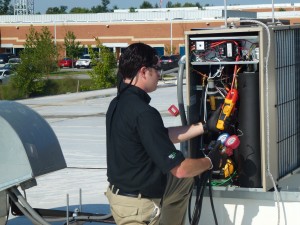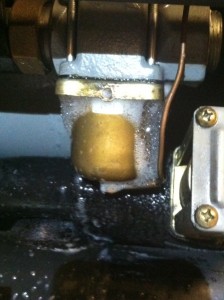Your air conditioning refrigerant is the lifeblood of all cooling systems – regardless if it’s a computer room air conditioner (CRAC), rooftop unit, heat pump, and so on. Refrigerant leaks can occur over time, negatively impacting the performance of your commercial HVAC system and potentially causing ozone depletion.
However, with regularly scheduled preventive maintenance for your HVAC and CRAC systems, refrigerant leaks can be identified and repaired before major damage is done. EPA requires that owners or operators of equipment greater than 50 pounds must repair leaks within 30 days of discovery. In general, leak rates of 10% or more must be repaired, not topped off with refrigerant.
The Impact of Low Refrigerant
Tony Mori, Field Supervisor / Project Manager at Crockett Facilities explains, “When the refrigerant charge is low in a system, the pressures are operating lower than normal which causes the refrigerant temperature to drop as well. If the temperature drops below freezing, moisture that builds up on the evaporator will freeze on the coil face (rather than condense and drain into the evaporator pan), which will ultimately restrict or block airflow. In a heat pump operating in heating mode, the condenser could potentially freeze and rupture, causing a flood or compromising the refrigerant system. Typically, refrigerant systems have a low pressure safety switch that will disable operation if the pressure/temperature falls to a dangerous level.”
Refrigerant Leak Causes
So what causes refrigerant leaks?
-
High internal pressure leading to wear and tear on the parts
-
Ongoing vibration and the stress of temperature and pressure fluctuations
-
Improper HVAC installation with parts not properly connected
-
Punctured condenser coils
HVAC systems are closed systems, so if operating properly, leaks should not happen. However, when leaks occur in the lineset, coils, compressor, and expansion valves, significant problems can result, such as inadequate cooling, an overheated compressor, and higher energy bills.
Finding the Leak
It can be challenging to locate the source of the leak. Below are some of the methods to diagnose the problem.
-
Visual inspection – Look for oil stains on the lines and fittings to identify the general area of the leak.
-
Electronic refrigerant leak detector – Sensors tend to wear out so need to be sure the detector works properly before using it.
-
Soap bubbles – Bubbles will form where there is a leak when joints are sprayed with a soapy solution.
-
Refrigerant dyes – A stained area will form where the leak is located when a red or fluorescent dye is injected into the system and mixes with the refrigerant oil.
-
Ultrasonic leak detector – Sound waves that are higher-than-normal frequency will be produced as refrigerant leaks from a system.
Call Crockett Facilities Services today to get a preventative maintenance quote for your HVAC or CRAC system – call 202.600.2787, email sales@crockett-facilities.com or complete our online form for a service quote. CFSI provides 24/7 commercial HVAC and mechanical services throughout Washington D.C., Maryland, and Virginia, targeting property managers, building owners, and facility/IT managers responsible for data centers and computer room air conditioning (CRAC) units.


